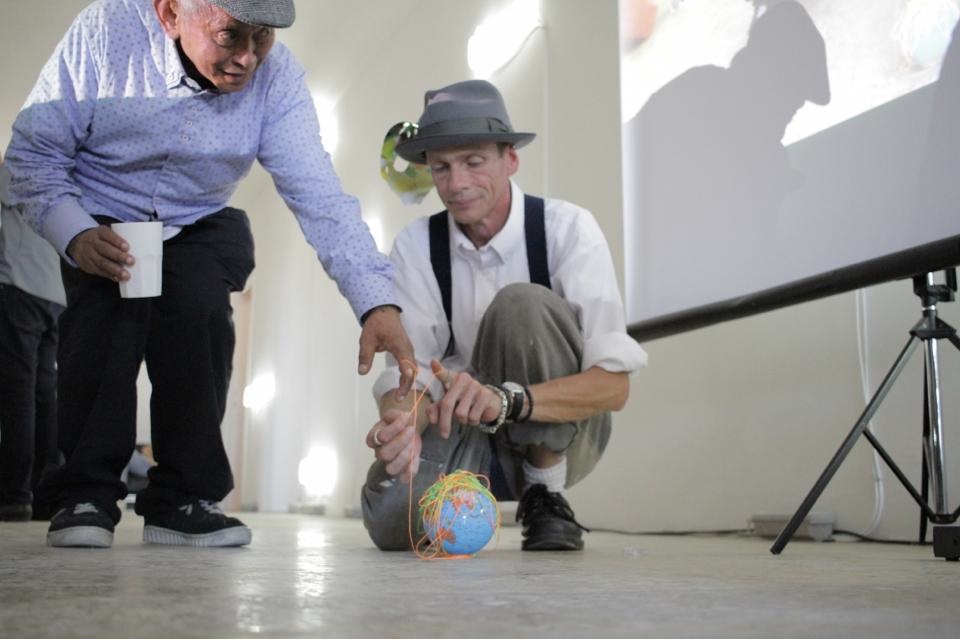David Medalla’s Performance at the PHL Pavilion, an Ode to Country
August 22, 2015 Globally renowned Filipino artist David Medalla’s performance at the Philippine Pavilion on August 20 was an ode to his country and the traditions he grew up with, a saga that starts from his memories as a child before the Japanese-American war that ravaged his hometown of Mabini in Ermita, Manila.
Globally renowned Filipino artist David Medalla’s performance at the Philippine Pavilion on August 20 was an ode to his country and the traditions he grew up with, a saga that starts from his memories as a child before the Japanese-American war that ravaged his hometown of Mabini in Ermita, Manila.
The seminal artist known for being a pioneer of kinetic and participatory art said that performance art cannot be explained in its entirety. “If I tell you, then what’s the point of performing,” Medalla quipped.
For Philippine Pavilion curator Patrick Flores, being an audience at a David Medalla performance is an experience.
“Anyone who is in a Medalla performance should keep an open mind and senses should always be sharp. The performance demands reciprocity and a sharing of subjectivity, and prompts a rethinking of the roles of spectator and artist. It looks like play, but it is actually a ‘serious game,’ very discursive but also very ludic and sensitive, to say nothing of its quicksilver nature,” Flores stated.
Medalla’s performance at the Philippine Pavilion was comprised of two parts—the first was a trip to Vicenza on August 19, a 45-minute train ride from Venice, to visit the statue of Venetian explorer Antonio Pigafetta.
Strings were wrapped around the statue of Pigafetta whose chronicle of the voyage of Ferdinand Magellan inspired the idea of space-time relativity. Medalla ties Venice with the Philippines through its historical past.
The strings tied around the Pigafetta statue were brought back the following day (August 20) to the Philippine Pavilion. Following a discussion among Medalla, longtime collaborator Adam Nankervis, and Flores on art in the Philippines, Medalla asked the audience to line up and wear paper masks he cut out from old magazines. He then asked the participants to sing the Filipino folk song “Sitsiritsit Alibangbang” while wearing the masks. Afterwards, he used a souvenir battery-operated globe that spins on its own and used the strings from the Pigafetta statue to cover the miniature globe.
“David at the Philippine Pavilion inflects the world-making argument with more worldliness. He brings in Pigafetta and conjures a cosmology that spans the Philippines and Venice. Only David can do this, humbling us thoroughly,” Flores said.
National Commission for Culture and the Arts (NCCA) Chairperson and Philippine Pavilion Commissioner Felipe de Leon Jr. said, “David Medalla can predict the future of art because he makes the future of art happen. You will enjoy his performance and you will never expect what our artist will do.”
Meanwhile, Senator Loren Legarda, who was unable to attend the event, thanked Medalla, through a message read by De Leon, “David, thank you for allowing this to happen, for making our comeback to the Venice Biennale more memorable and spectacular.”
Legarda recalled that when she first met Medalla in London, she was immediately comfortable and engaged. Since then, she dreamt of having a David Medalla show.
“In those few hours of intellectual discourse, I felt grateful and honored for I was in the presence of a genius, a dynamic and inspiring icon for many of our Filipino artists. Medalla is an inspiration to Filipino artists to go out of their comfort zone, to explore their creativity and not to be bound by what is now,” she said.
“I wanted to share the experience of being inspired by David with more people, especially Filipinos themselves, that is why I have been eager to organize a Medalla performance. I saw our return to the Venice Biennale as an opportunity for such an event and he did not disappoint. He brought a new dimension to the Philippine Pavilion exhibit,” Legarda stressed.
Medalla also had a successful performance at the Microclima in Giardini last August 18, a space that is “a rich source of exchange and hybridization of culture, art, music and people.” It was attended by followers of Medalla as well as important personalities in contemporary art including Philip Rylands, Director of the Peggy Guggenheim Collection.
Medalla’s final performance at the Peggy Guggenheim Collection will be on August 22, 2015.
Medalla’s series of performances is a collateral event of the Philippine Pavilion accredited by la Biennale di Venezia.
The Philippine Pavilion titled Tie A String Around the World is the only national pavilion that represents the Philippines at the 56th International Art Exhibition – la Biennale di Venezia. Curated by Flores, it features the works of Manuel Conde and Carlos Francisco (Genghis Khan), Manny Montelibano (A Dashed State), and Jose Tence Ruiz (Shoal).
The Philippine participation was made possible through the joint effort of the National Commission for Culture and the Arts (NCCA), the Department of Foreign Affairs (DFA) and the Office of Senator Loren Legarda, with the support of the Department of Tourism (DOT) and the Tourism Promotions Board.

